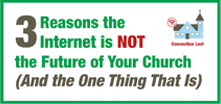
What percentage of your church’s first-time guests are filling out communication cards?
Getting contact info from newcomers is so important because we can’t follow up with them if we don’t know who they are. I’ve found that the difference between fast-growing churches and churches which are plateaued often isn’t the number of 1st-time guests, but the number of guests who are returning.
Churches who are serious about reaching people for Christ must be focused on their weekend guests. Their visit to your church reveals they are actively seeking to meet a need – whether it’s the need for a fresh start, to connect with others, to know more about Christianity, or for a church home. You can’t help someone grow spiritually or encourage them to take their next steps toward Jesus if you never see them again. So being able to follow up, making people feel welcome, and inviting them to return are ultimately the first steps of your church’s discipleship process.
With that in mind here are ten tips to encourage more first-time guests to fill out your connection cards.
- Connect the card to a gift. When the card is explained during your announcement time, connect it to a gift for 1st-time guests. Churches who spend $5-15 on a guest bag will find that it’s worth the investment. Whether the gift is a church logo tumbler filled with candy, a sermon series T-shirt, or an item from a local bakery, give your guests something they’ll enjoy. My church is currently putting our gift and informational packet in a church logo drawstring bag, so that even the bag itself becomes part of the gift. During the announcement time, our host will pull some of the contents out of the guest bag to demonstrate what people will receive in the lobby after they’ve turned in their cards. (Click here for some great gift options from Equip.)
- Have pens available for everyone. It seems like a no-brainer, but people can’t fill out the card if they don’t have anything to write with. If your church has multiple worship services, you may want to “restock” the auditorium with pens between services. When I led a church meeting in a school, we had metal folding chairs with no place to attach a pen to the seat. So we stationed a special greeter at every auditorium entrance for the express purpose of handing each person a pen as they arrived. Our number of completed guest cards immediately spiked when we made that adjustment.
- Use the communication card for all sign-ups. Rather than requiring people to go to a table in the lobby to sign up for an event or group, give them the option of signing up right on the card. You don’t even have to customize the card to allow for this. You can just announce, “If you want to participate in this fun outreach we’re doing at the park, just write ‘PARK’ at the top of your communication card and we’ll follow up with more details.” The more reasons you give people to fill out their cards, the better. If you’re able to customize your cards on a weekly basis, you could even have “check boxes” for people to commit to specific next steps based on the application points of the sermon.
- Make it easy to turn in the card. If newcomers are required to take their completed card to a welcome center, many won’t. Especially if they’re introverts or unfamiliar with how churches operate. Make it as easy as possible. Our church moved our offering time to the end of the service for the express purpose of allowing newcomers to drop their cards in the offering plate. This gave them sufficient time to complete the card and allowed them to turn in their card without ever leaving their seat. With each step you add to the process, you’ll see fewer returns. This is why I don’t recommend relying on apps for guest check-ins. Your regular attenders will gladly download an app, but a first-time guest who hasn’t decided whether to return probably won’t download it. Even in our digital society, we’ve found that a physical card is the easiest for our guests. (Click here for some fully customizable connect card options from Equip.)
- Make the process clear. Show people what the card looks like. Ask them to fill out as much information as they’re comfortable with. Tell them when and where they’ll be turning in the card. Explain where the gift bags are (and have them at every exit point). Quickly review all that information again before you receive the offering, since some guests may have arrived late and missed the previous explanation. Tell people where to take their cards if they don’t finish filling them out before the offering plate reaches them. Consider color-coding the cards for simplicity: “To join a group, just mark the red section of your connection card…”
- Build a culture where everyone fills out the cards. By having ALL attenders fill out information cards, your guests aren’t singled out. My current church hadn’t done this prior to my arrival. Since people were accustomed to ignoring the cards, we had to find a way to encourage long-time attenders to form a new habit. We decided to leverage our guest bag gift. After we demonstrate the gift during our announcement time, we then select someone who turned in their card last week as the “winner” of the sample gift we have on stage. Our host gives them their “prize” on the spot as a way of thanking them for turning in their card. We also remind everyone that we’ll be giving away another candy-filled tumbler next weekend to someone who fills out their card this Sunday. Since it isn’t necessary to get a regular attender’s contact info week after week, we ask them to at least write their name.
- Less is more. When designing your communication card, ask for only the information you’re going to use. Don’t ask for info just because you find it interesting. For example, don’t ask for their birthdate if you’re not planning to do anything on their birthday. The fewer form fields you display, the more cards you’ll have filled out. Limit the number of fields and make the fields big enough to write in. We want to lower barriers to maximize results. Some churches have found the best results by simplifying the card to name, e-mail address, and phone number. Barna Group found that 82% of millennials will share their first name, 33% will give their e-mail address, and only 12% will write their phone number. If you want more information about a guest, you can always find that out through later interactions.
- Solicit prayer requests. Provide space for people to submit prayer requests on the connection card and encourage them to do so. Pastor: when you let people know you will be personally praying over every request received, people will use the cards to share their burdens with you.
- Use your children’s registration form. Most likely, your church requires families to fill out a registration form before dropping off their kids. While parents will gladly answer every item on a child’s registration form, many will choose not to complete a guest card in the worship service. Why? Because it is asking for information they’ve already provided and seems redundant to them. So be sure to process your children’s registration forms just as you would connection cards from the worship service, since those forms already have all the contact info you need for guest follow-up.
- Do good. If your church partners with other non-profit organizations, you can commit to give something to a worthy cause for each connection card received. This encourages people to fill out their cards to support the charity and allows first-time guests to immediately see that the church is outward-focused and prioritizes meeting needs in the community. The donation could be financial (“For each completed card, we’ll give $1 to build wells…) or a tangible item (“For each card turned in, we’ll be providing a sack lunch to an organization ministering to the homeless…”).
If you begin implementing these best practices, I believe you’ll start receiving more completed guest cards than ever before. Got other ideas about how to encourage people to fill them out? We’d love to hear them.





